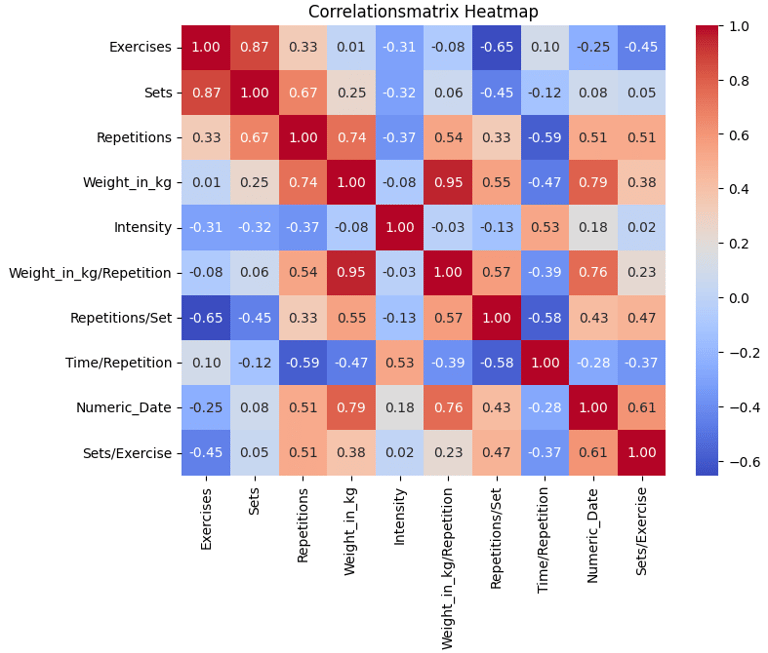

Gym Performance since 10-2023

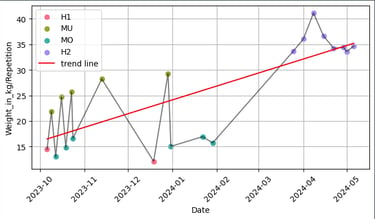

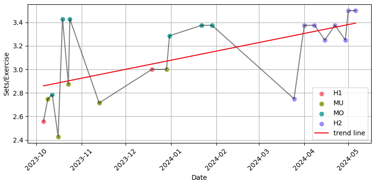
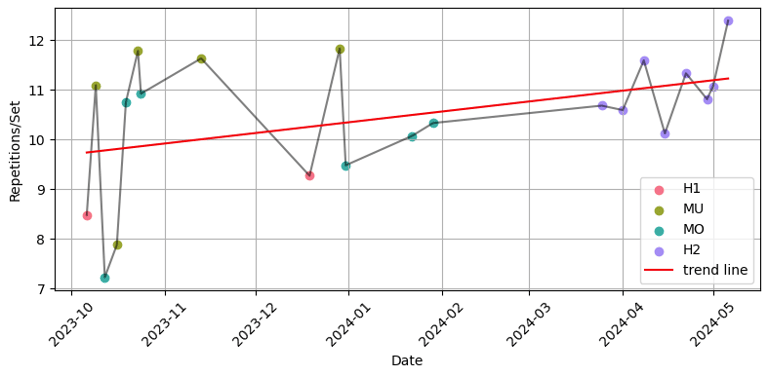



Beginning of October, I signed up for my first-ever gym membership (in the age of 29) with the aim of not succumbing to physical decline in my 30s, but rather reaching my best shape. After a screening, I started training with the following metrics (Image_1).
After the initial assessment, I made the decision to prioritise muscle building and was subsequently provided with a full-body training regimen, along with separate plans targeting upper and lower body splits. This approach allowed me to gauge my ability to handle the workload effectively and to identify which plans and exercises yielded optimal results.
By focusing initially on hypertrophy (muscle growth), I aimed to enhance both my muscular strength and size. This strategic decision aligns with the principle of periodization, a systematic approach to training that involves breaking down training cycles into distinct phases, each with its own specific objectives. In this case, prioritizing muscle mass accumulation serves as the foundation upon which subsequent phases of training can be built.
The implementation of separate training plans for upper and lower body splits further underscores the importance of targeted training strategies. By dividing the workload across different sessions, I was able to provide sufficient stimulus to each muscle group while allowing for adequate recovery between sessions. This not only maximizes the efficiency of training but also minimizes the risk of overtraining and injury.
After six months of training with various workout plans (H1, MU, MO, H2) and many up's and downs, I was able to gather some data for evaluation. Starting with the value I calculated for average weight in kg per repetition represented over the past months (Image_2), a significant progress is evident. To emphasize this upward trend, I added a trend line using linear regression.
In addition to the significant increase in weight, the number of repetitions (Image_4) and sets (Image_3) also slightly rose but not as clearly as the increase of weight.
Further measurements are required to ascertain significant progress not only in pure muscle strength but also in endurance.
To identify potential positive, negative, or missing correlations between the individual values, I plotted a correlation matrix in the form of a heatmap to visualize the interactions more clearly (image_5).
In the plot, several familiar correlations can be observed, which we have also seen in the previous graphs, such as the increase in weight in kg over numeric date, which is strongly correlated with 0.79. Additionally, there is a slight correlation (0.67) between the increase in weight in kg and repetitions, which can be explained by the rise observed in the previous graphs (Image_2, Image_4).
One of the strongest correlation (0.87) is observed in the parallel increase of the number of sets and exercises. This can be attributed to the overall improvement in performance, as well as the periodic rotation of training plans (H1, MU, MO, H2), which may include varying numbers of exercises.
At first glance, the relatively high negative correlation (-0.58) between Time per Repetition and Repetition per set might seem surprising, as one would assume that a higher number of repetitions would typically lead to longer durations due to muscle exhaustion. However, it appears that on days of suboptimal condition or insufficient recovery from previous workouts, more time is required for fewer repetitions. If this trend persists with future data, it raises questions about whether training is indeed being pushed to the limit.
l. Introduction
ll. Analysis
Image_1
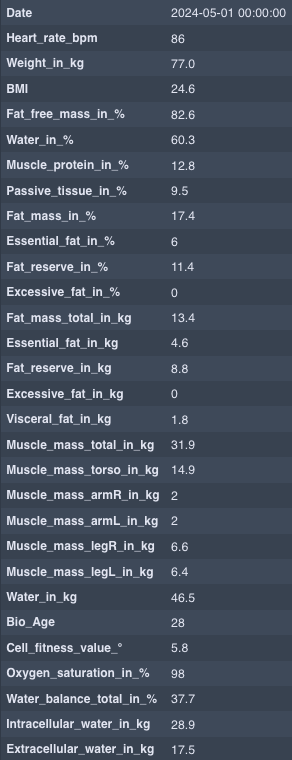

Image_2
Image_3
Image_4
Image_5
llI. Conclusion
After over 6 months of training with various workout plans, another full-body scan was conducted (Image_6). The most significant relative changes were observed in body weight, with an increase of 8.6%, cell fitness, with an increase of 66%, and muscle mass in both legs, with an increase of 16.4%.
With a calorie intake of approximately 2600 - 2800 kcal on regular days and 3000 - 3200 kcal on a training day, the first milestone of weight gain was achieved during this period. However, since the diet during this time was adequate but not well-balanced, as evidenced by the increased values in body fat, especially visceral fat, the next step is to focus more on muscle endurance training for fat burning and also place more emphasis on the quality of nutrition. This means that overall, not as many calories need to be added, but they should be composed differently, especially in terms of macronutrients. In this context, the training plan will also be revised to expedite the achievement of the desired goal.
In conclusion, it is worth noting that the results, while not perfect, are very satisfying. Throughout my life, I have often attempted to regularly train my body and reach new limits, but I have never been able to overcome the hurdle of working towards this goal long-term. Currently, quitting is simply not an option in my mind, and apart from health issues, there is truly nothing that could deter me from going to the gym. Therefore, I am very confident that this time, I can stick with it in the long term and with the necessary consistency.
Furthermore, the original motivation is no longer just about looking good or even about health; it's about the incentive to mentally push beyond any limits. The fact is, even when the mind is screaming that it's impossible, there are always a few more repetitions left in the tank. Additionally, it's important to recognize that this is a long-term project, and quick results should not be expected.
Image_6
last update: 12.05.2024
